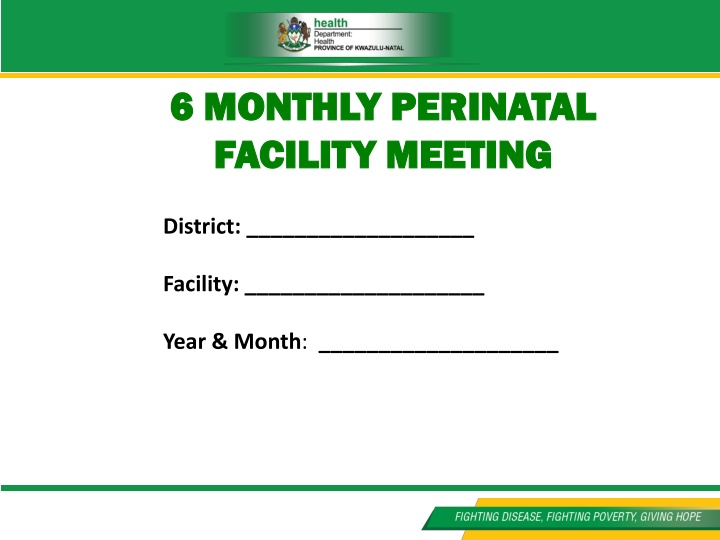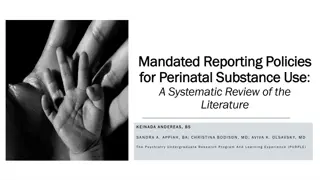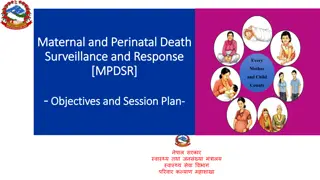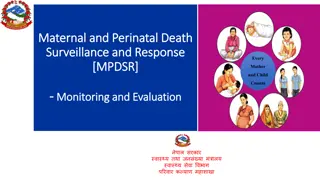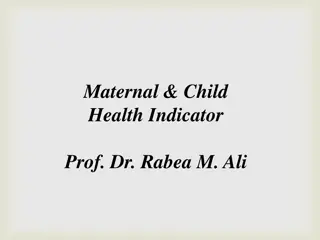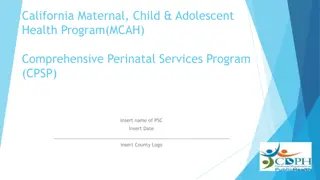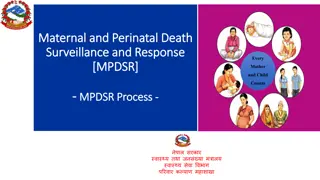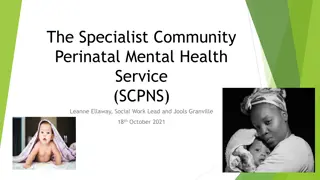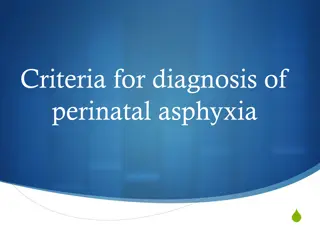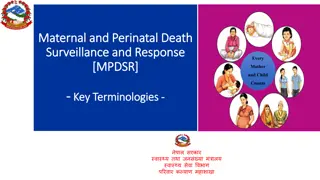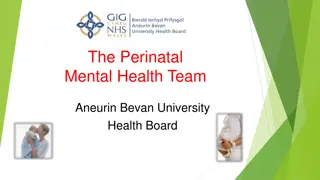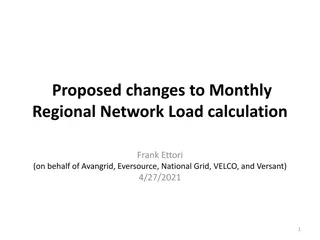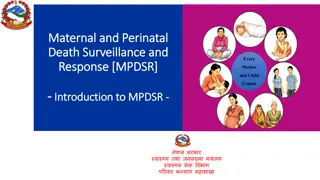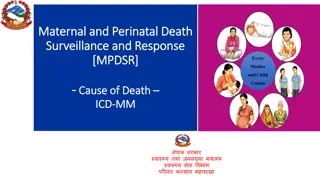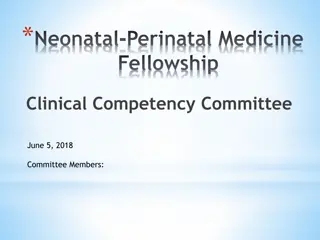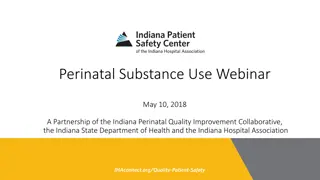6-Monthly Perinatal Facility Meeting Agenda
This document outlines the agenda for a 6-monthly perinatal facility meeting, covering topics such as obstetric and neonatal data analysis, quality of care, support, and raw data. It includes discussions on challenges, successes, modifiable factors, trends in mortality, and proposed action plans. The meeting aims to address current issues and plan future strategies to enhance perinatal care.
Download Presentation

Please find below an Image/Link to download the presentation.
The content on the website is provided AS IS for your information and personal use only. It may not be sold, licensed, or shared on other websites without obtaining consent from the author.If you encounter any issues during the download, it is possible that the publisher has removed the file from their server.
You are allowed to download the files provided on this website for personal or commercial use, subject to the condition that they are used lawfully. All files are the property of their respective owners.
The content on the website is provided AS IS for your information and personal use only. It may not be sold, licensed, or shared on other websites without obtaining consent from the author.
E N D
Presentation Transcript
6 MONTHLY 6 MONTHLY PERINATAL FACILITY MEETING FACILITY MEETING PERINATAL District: ___________________ Facility: ____________________ Year & Month: ____________________
Agenda 1. Welcome and apologies 2. Appointment of meeting secretary 3. Confirmation of previous minutes (Do not read minutes!) 4. Matters arising -Follow up on previous action plans 5. Obstetric current data challenges & successes, modifiable factors and proposed action plans. 6. Obstetric 6 month review data Rates and trends in mortality, quality and transfer data
Agenda 7. Neonatal current data Challenges & successes, modifiable factors and proposed action plans. 8. Neonatal 6 month review data Rates and trends in mortality, quality and transfer data 9. Discussion 10. New action plan
Action Plan-FU Responsible person/s Time frame Actions Follow up
Obstetric Data: Quality of Care Analysis: Significant changes, successes or challenges Indicator: Result: No. of postpartum implants No. of post partum IUCD insertions Caesarian delivery (CD) Rate Caesarian delivery safety score (minimum standards) BANC audit score Partogram audit score No. of ESMOE firedrills conducted % % <10/12(83%)=failure % %
Obstetric Data: Quality of Care & Support Analysis: Significant changes, successes or challenges Indicator: Result: No. of deliveries 28-34 weeks that received 2 steroid doses No. of avoidable steroid misses No. of avoidable HIE cases Regional Hospitals: No. of referring hospitals Regional Hospitals: No. of obstetric outreach visits made District Hospitals: Obstetric regional outreach report received Y / N All Hospitals: District maternity support visit report received Y / N
Obstetric Data: Raw Data No. from Source doc. Analysis: Significant changes, successes or challenges Source Document No. from DHIS No. from PPIP Verified Total Indicator No. of total births No. of live births No. of deliveries between 10-19 yrs. No. of deliveries 28-34 weeks No. of Low Birth weight babies No. of BBAs No. of maternal deaths
Obstetric Data: Raw Data No. from Source doc. Analysis: Significant changes, successes or challenges Source Document No. from DHIS No. from PPIP Verified Total Indicator No. of postpartum haemorrhage No. of perinatal deaths (excl. BBAs) No. of stillbirths- Total Still births No. of confirmed HIE s No. of HIE deaths FSB MSB
Obstetric Data: Encephalopathy Analysis Mode of delivery Date of Birth & Initials Place of delivery Sarnat stage Gest. Weight Diagnosis Outcome Analysis Abstinence syndrome Clinical audit score Case audited CNS/Genetic Unavoidable 2500-3999g Discharged Metabolic <35weeks >35weeks Avoidable Infection Outborn Vascular <2500g >4000g Inborn Died NVD BBA HIE CS 1 2 3 Totals: ANALYSIS: Significant changes, successes or challenges
Maternal Transfers Deaths awaiting transfer Deaths at receiving hospital No. No. Deaths in transit requested accepted Indicator: 1st 6 mths 2nd 6 mth s 1st 6 mth s 2nd 6 mth s 1st 6 mth s 2nd 6 mth s 1st 6 mth s 2nd 6 mth s 1st 6 mth s 2nd 6 mth s Result: Actions implemented:
Obstetric Indicators Annual Baseline Previous 6mths Current 6mths Indicator Target Comment iMMR SBR PNMR ENMR iNMR Neon. IHMR (Inborn) Neon. IHMR (Outborn) Perinatal Care Index (PCI)
Obstetric Indicators Annual Baseline Previous 6mths Current 6mths Indicator Target Comment Perinatal Care Index (PCI) HIE Rate (Incidence) Case fatality rate (CFR)-HIE Induction of labour success rate (IOL) Caesarean delivery rate (CD) Steroid coverage
Causes of Maternal Deaths Current 6mths Previous 6mths Non preg. Infect., 1, 12% Non preg. Infect., 1, 12% Other, 1, 13% Other, 1, 13% Unknown, 1, 13% Obstetric haem., 1, 12% Unknown, 1, 13% Obstetric haem., 1, 12% Miscarriage 1, 13% Hypertens ion, 1, 12% Hypertensi on, 1, 12% Preg. Related sepsis, 1, 13% Preg. Related sepsis, 1, 13% Miscarria ge, 1, 13% Med/Surg comp., 1, 12% Med/Surg comp., 1, 12%
Avoidable Factors- Maternal Current 6mths Total No: Previous 6mths Total No: HC HC Insuff. notes, 1, 25% Insuff. notes, 1, 25% Provider 1, 34% Provider 1, 34% Patient and family, 1, 25% Patient and family, 1, 25% Admin, 1, 25% Admin, 1, 25%
Avoidable Factors-Maternal Prev. 6 mths % Patient associated Med. personnel Current % Admin. Factor 1. 2. 3. 4. 5. 6.
Perinatal Deaths Previous 6mths Current 6mths Neon. Death, 600, 21% Neon. Death, 600, 21% FSB, 200, 7% FSB, 200, 7% MSB, 100, 3% MSB, 100, 3% Alive on disch. 2 000, 69% Alive on disch. 2 000, 69%
Causes of Stillbirths 1000-2500g Current 6mths Previous 6mths Unexplained stillbirth 15% Unexplained stillbirth 15% Other 14% Other 14% Spont. Prem. labour 15% Spont. Prem. labour 15% Fetal abnorm. 14% Fetal abnorm. 14% Antepartum haem. 14% Antepartum haem. 14% Hypertension 14% Intrapartum asphyxia 14% Hypertension 14% Intrapartum asphyxia 14%
Avoidable Factors-Stillbirths 1000-2500g Current 6mths Total No: Previous 6mths Total No: HC Insuff. Notes, 1, 25% HC Insuff. Notes, 1, 25% Provider 1, 34% Provider 1, 34% Patient & family, 1, 33% Patient & family, 1, 33% Admin. 1, 33% Admin. 1, 33%
Causes of Stillbirths >2500g Current 6mths Previous 6mths Unexplained stillbirth 15% Unexplained stillbirth 15% Other 14% Other 14% Spont. Prem. labour 15% Spont. Prem. labour 15% Fetal abnorm. 14% Fetal abnorm. 14% Antepartum haem. 14% Antepartum haem. 14% Hypertension 14% Intrapartum asphyxia 14% Hypertension 14% Intrapartum asphyxia 14%
Avoidable Factors-Stillbirths >2500g Current 6mths Total No: Previous 6mths Total No: HC Insuff. Notes, 1, 25% HC Insuff. Notes, 1, 25% Provider 1, 34% Provider 1, 34% Patient & family, 1, 33% Patient & family, 1, 33% Admin. 1, 33% Admin. 1, 33%
Avoidable Factors-HIE Prev. 6 mths % Patient associated Med. personnel Current % Admin. Factor 1. 2. 3. 4. 5. 6.
Avoidable Factors-HIE Current 6mths Total No: Previous 6mths Total No: HC Insuff. Notes, 1, 25% HC Insuff. Notes, 1, 25% Provider 1, 34% Provider 1, 34% Patient & family, 1, 33% Patient & family, 1, 33% Admin. 1, 33% Admin. 1, 33%
Avoidable Factors-Stillbirths Prev. 6 mths % Patient associated Med. personnel Current % Admin. Factor 1. 2. 3. 4. 5. 6.
Neonatal Data: Quality of Care Insert Neonatal Dashboard slides .
Neonatal Data: Support Analysis: Significant changes, successes or challenges Indicator: Result: Regional Hospitals: No. of referring hospitals Regional Hospitals: No. of neonatal outreach visits made District Hospitals: Neonatal regional outreach report received Y / N All Hospitals: District neonatal support visit report received Y / N
Neonatal Data: Raw Data Analysis: Comment on any significant changes, successes or challenges No. from Source doc. Source Document No. from DHIS No. from PPIP Verified total Indicator No. of live births No. of preterm births (<37 weeks) No. of neonatal separations. Nosocomial sepsis separations No. of HIE separations No. of neonatal deaths-total
Neonatal Data: Raw Data Analysis: Comment on any significant changes, successes or challenges No. from Source doc. Source Document No. from DHIS No. from PPIP Verified total Indicator Early 0-7 days Neonatal Deaths- Inborn Late 8-28 days Early 0-7 days Neonatal Deaths- Out born Late 8-28 days No. of preterm deaths No. of neonatal sepsis deaths No. of HIE deaths
Neonatal Data: Deaths Analysis Obstetric Cause of Death (PPIP) Spon. Prem labour Analysis Neonatal Cause of Death (PPIP) Date of Death & Initials Place of death Age at Death Gest. Weight Antepartum hemorrhage Hypertensive disorder 29days-11mths Cong. abnorm. OPD/ Casulaty Neonatal Unit 24hrs-7 days Within 24hrs 28-36 weeks Unavoidable Paeds wards Prematurity 1000-2499g <28 weeks 37 weeks 8-28 days Post Natal Avoidable 500-999g Asphyxia Infection 2500g Theatre Other other KMC DOA LW Totals: ANALYSIS: (Comment on any significant changes, successes or challenges)
Neonatal Transfers Deaths awaiting transfer Deaths at receiving hospital No. No. Deaths in transit requested accepted Indicator: 1st 6 mths 2nd 6 mth s 1st 6 mth s 2nd 6 mth s 1st 6 mth s 2nd 6 mth s 1st 6 mth s 2nd 6 mth s 1st 6 mth s 2nd 6 mth s Result: Actions implemented:
Neonatal Indicators Annual Baseline Previous 6mths Current 6mths Indicator Target Comment Neonatal mortality rate (iNMR) Early neonatal mortality rate (ENMR) In hospital neon. mortality rate (IHMR) -Inborn In hospital neon. mortality rate -Outborn Case fatality rate (CFR) -Under 1000g Case fatality rate -1000-2500g
Neonatal Indicators Annual Baseline Previous 6mths Current 6mths Indicator Target Comment Case fatality rate -Above 2500g Case fatality rate- Prematurity Neonatal sepsis rate (incidence) Case fatality rate- Neonatal Sepsis Bed utilisation rate (BUR) Average length of stay (LOS)
Neonatal Deaths by Time of Death Previous 6mths Current 6mths Late 50, 2% Late 50, 2% Within 24hrs, 200, 57% Within 24hrs, 200, 57% Early 100, 5% Early 100, 5%
Neonatal Deaths by Weight Previous 6mths Current 6mths >2500g, 5, 14% >2500g, 5, 14% 1000- 2500g, 10, 29% <1000g, 20, 57% 1000- 2500g, 10, 29% <1000g, 20, 57%
Neonatal Deaths by Place of Death Previous 6mths Current 6mths Nursery, 1, 12% DOA, 1, 13% Nursery, 1, 12% DOA, 1, 13% KMC, 1, 12% KMC, 1, 12% OPD, 1, 13% OPD, 1, 13% Paeds, 1, 13% LW, 1, 12% Paeds, 1, 13% LW, 1, 12% Theatre, 1, 12% PN, 1, 13% Theatre, 1, 12% PN, 1, 13%
Neonatal Cause of Death <1000g Previous 6mths Current 6mths Other, 1, 17% Other, 1, 17% Prematurity, 1, 16% Prematurity, 1, 16% Asphyxia, 1, 16% Asphyxia, 1, 16% Unknown, 1, 17% Unknown, 1, 17% Infection, 1, 17% Infection, 1, 17% Congenital abnormality 1, 17% Congenital abnormality 1, 17%
Neonatal Cause of Death 1000-2500g Previous 6mths Current 6mths Other, 1, 17% Other, 1, 17% Prematurity, 1, 16% Prematurity, 1, 16% Asphyxia, 1, 16% Asphyxia, 1, 16% Unknown, 1, 17% Unknown, 1, 17% Infection, 1, 17% Infection, 1, 17% Congenital abnormality 1, 17% Congenital abnormality 1, 17%
Neonatal Cause of Death >2500 Previous 6mths Current 6mths Other, 1, 17% Other, 1, 17% Prematurity, 1, 16% Prematurity, 1, 16% Asphyxia, 1, 16% Asphyxia, 1, 16% Unknown, 1, 17% Unknown, 1, 17% Infection, 1, 17% Infection, 1, 17% Congenital abnormality 1, 17% Congenital abnormality 1, 17%
Avoidable Factors-Neonates Current 6mths Total No: Previous 6mths Total No: HC Insuff. Notes, 1, 25% HC Insuff. Notes, 1, 25% Provider 1, 34% Provider 1, 34% Patient & family, 1, 33% Patient & family, 1, 33% Admin. 1, 33% Admin. 1, 33%
Avoidable Factors-Neonates Prev. 6 mths % Patient associated Med. personnel Current % Admin. Factor 1. 2. 3. 4. 5. 6.
Avoidable Factors by Cause of Death Current 6mths Rank Prematurity Asphyxia Infection 1. 2. 3. 4. 5. 6.
Discussion Discussion
Action Plan Responsible person/s Time frame Actions Follow up
Thank you Thank you
